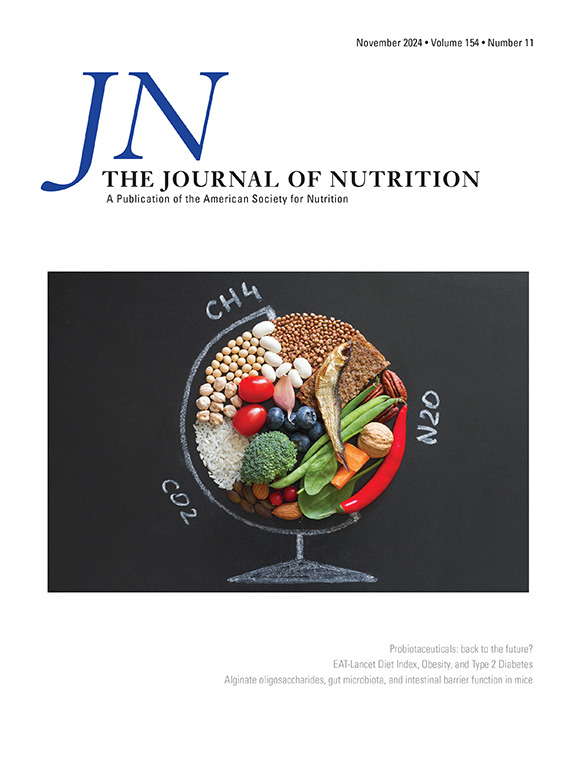Effectiveness and Potential Toxicity of Bread Fortification With Vitamin D in General Population: A Predictive Modeling Study
IF 3.7
3区 医学
Q2 NUTRITION & DIETETICS
引用次数: 0
Abstract
Background
Vitamin D fortification of bakery’s wheat flour, which excludes flours used for confectionaries and bulky breads, can be a suitable strategy to improve vitamin D status of the general population.
Objectives
This study aimed to generate a predictive model to anticipate the effectiveness and potential risk of vitamin D–fortified bread in different fortification doses in general population.
Methods
To gather baseline data before implementation of flour fortification, a cross-sectional descriptive study was conducted on a representative sample comprising 1051 subjects aged 7–65 y from 2 cities Birjand and Yazd. Demographic, anthropometric, and laboratory assessments were performed for all subjects. The amount of bread consumption was estimated using a 24-h recall questionnaire. A simulation model was used to examine the impact of various fortification doses of vitamin D in bread on the proportion of both adults and children achieving sufficient circulating 25-hydroxycalciferol [25(OH)D] concentrations (>50 nmol/L) and potential harm thresholds (>375 nmol/L). The baseline serum 25(OH)D concentration data were used as a reference for comparison at each fortification dose. Circulating 25(OH)D between 27.5 and 50 nmol/L and below 27.5 nmol/L was considered as insufficiency and deficiency, respectively.
Results
Substantial proportions of both children and adults fell into the insufficient (37.5% and 37.4%, respectively) and deficient (34.7% and 31.8%, respectively) categories. Our model showed that the fortification dose of 250 IU/100g bread could be an effective strategy for significantly improving vitamin D status in the general population. Higher doses, such as 500 IU/100g, results in >70% of the population achieving sufficient 25(OH)D concentrations. However, starting at 400 IU/100 g bread, a very small percentage (0.1%) of the population could reach potentially harmful concentrations.
Conclusions
By adding 250–350 IU vitamin D per 100 g bread, over half of the general population can reach to sufficient vitamin D status with no potential risk of toxicity.
在普通人群中添加维生素D的面包的有效性和潜在毒性:一项预测模型研究。
背景:面包店的小麦粉,不包括用于糖果和大块面包的面粉,可以是改善普通人群维生素D状况的合适策略。目的:建立一个预测模型,以预测在普通人群中不同强化剂量的维生素d强化面包的有效性和潜在风险。方法:为了收集面粉强化实施前的基线数据,对来自Birjand和Yazd两个城市的1051名7-65岁的代表性样本进行了横断面描述性研究。对所有受试者进行人口统计学、人体测量学和实验室评估。使用24小时召回问卷估计面包消费量。采用模拟模型研究了面包中维生素D的不同强化剂量对达到足够循环25(OH)D浓度(50 nmol/L)和潜在危害阈值(375 nmol/L)的成人和儿童比例的影响。基线血清25(OH)D浓度数据被用作各强化剂量比较的参考。循环25(OH)D在27.5 ~ 50nmol /L之间和低于27.5 nmol/L分别被认为是不足和不足。结果:儿童和成人均有相当比例的人存在营养不足(分别为37.5%和37.4%)和营养不足(分别为34.7%和31.8%)。我们的模型显示,250 IU/100g面包的强化剂量可能是显著改善普通人群维生素D状况的有效策略。更高的剂量,如500 IU/100g,可使70%以上的人达到足够的25(OH)D水平。然而,从400iu /100g面包开始,很小一部分人(0.1%)可能达到潜在的有害水平。结论:通过每100克面包添加250-350国际单位的维生素D,超过一半的普通人群可以达到足够的维生素D水平,而没有潜在的毒性风险。
本文章由计算机程序翻译,如有差异,请以英文原文为准。
求助全文
约1分钟内获得全文
求助全文
来源期刊

Journal of Nutrition
医学-营养学
CiteScore
7.60
自引率
4.80%
发文量
260
审稿时长
39 days
期刊介绍:
The Journal of Nutrition (JN/J Nutr) publishes peer-reviewed original research papers covering all aspects of experimental nutrition in humans and other animal species; special articles such as reviews and biographies of prominent nutrition scientists; and issues, opinions, and commentaries on controversial issues in nutrition. Supplements are frequently published to provide extended discussion of topics of special interest.
 求助内容:
求助内容: 应助结果提醒方式:
应助结果提醒方式:


